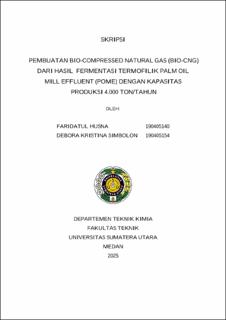Pembuatan Bio-Compressed Natural Gas (BIO-CNG) Dari Hasil Fermentasi Termofilik Palm Oil Mill Effluent (POME) Dengan Kapasitas Produksi 4.000 Ton/Tahun
Making Bio-Compressed Natural Gas (BIO-CNG) From Fermentation Results Thermophilic Palm Oil Mill Effluent (POME) With Production Capacity of 4,000 Tons/Year

Date
2025Author
Husna, Faridatul
Simbolon, Debora Kristina
Advisor(s)
Trisakti, Bambang
Sidabutar, Rivaldi
Metadata
Show full item recordAbstract
Indonesia is still facing challenges in achieving energy development targets. In relation to the empowerment of renewable energy resources, the utilization of biomass based on palm oil plants has become a strategic option due to the high production of waste generated, namely Palm Oil Mill Effluent (POME). Processing POME into biogas is considered an advantageous method for handling POME because it not only addresses waste problems but also generates an energy source. The utilization of biogas from POME is a way to increase the economic value of liquid waste into renewable energy while also reducing greenhouse gas emissions. The potential for new renewable energy sources in Indonesia is abundant, one of which is biogas. The energy contained in biogas depends on the methane (CH4) concentration. The higher the methane content, the higher the energy content in the biogas. To increase methane (CH4) content, purification efforts are needed. The biogas purification at this stage reduces some of the impurities, and further upgrading is still required. The processed and purified biogas will be compressed into BIO-Compressed Natural Gas (BIO-CNG). BIO-CNG can be used for motor vehicles or distributed through a gas pipeline network on a commercial scale as fuel for industries. The design of the BIO-CNG production plant from thermophilic fermentation of POME has a production capacity of 4,000 tons per year. The main processes in the design of this plant consist of 4 stages: raw material preparation, POME fermentation, product purification, and biogas compression. The plant is planned to be located in Tanjung Pauh Village, Mestong District, Muaro Jambi Regency, Jambi Province, covering an area of 2,950 m², with a total of 279 workers required. The business will be established as a limited liability company (PT), led by a director with a line and staff organizational structure. The establishment and operation of the plant will require an investment capital of IDR 2,210,047,006,525,820, and production costs of IDR 2,276,573,678,275.89, with sales revenue of IDR 2,549,599,715,079, generating a net profit of IDR 178,724,361,022.36. Based on the economic analysis, the plant generates a profit margin (PM) of 10.01%; break-even point (BEP) of 43.91%; return on investment (ROI) of 8%; return on net (RON) of 13.48%; payback period (POT) of 8.3 years; and an internal rate of return (IRR) of 15.60%. Based on the economic analysis, it can be concluded that the plant is feasible to be established.
Collections
- Undergraduate Theses [1239]
